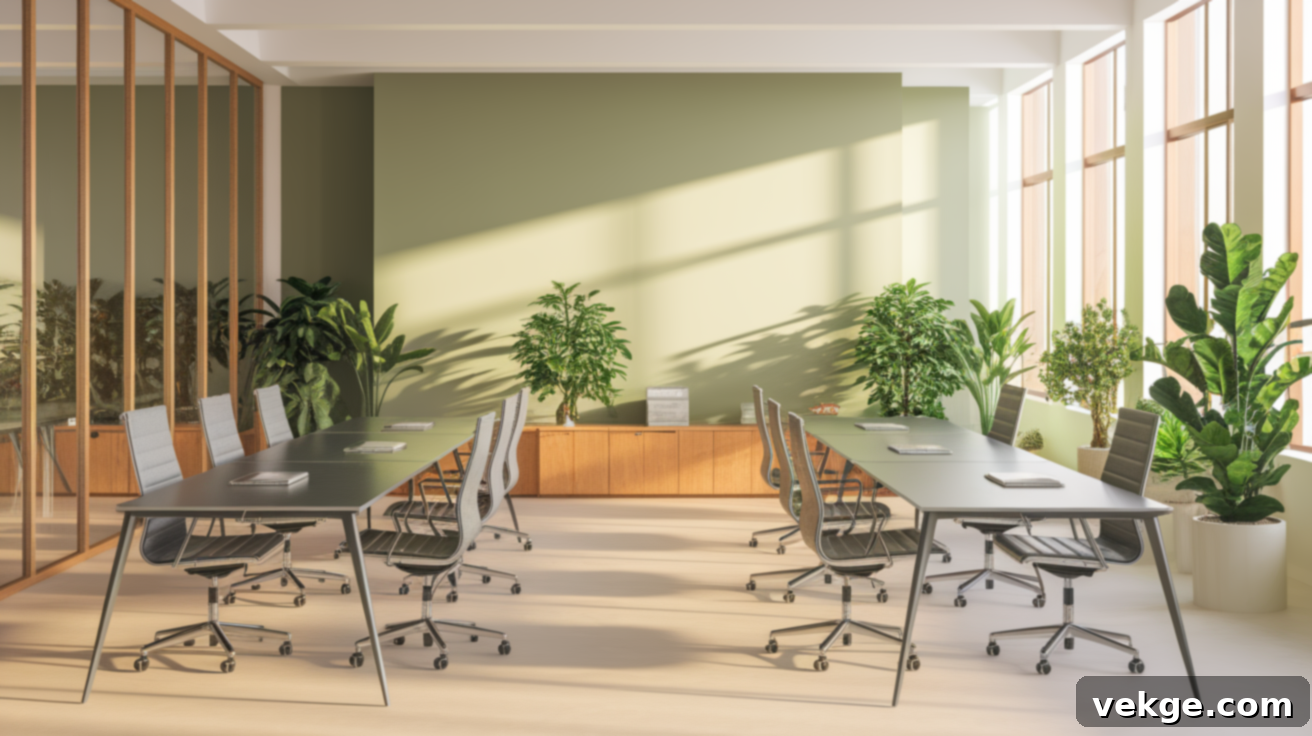Transform Your Workspace: The Ultimate Guide to Contemporary Office Design
In today’s dynamic professional landscape, an office is far more than just a place to perform tasks; it’s a vital environment that profoundly influences productivity, collaboration, and overall employee well-being. Are you looking to refresh or completely overhaul your current workspace? The right design choices possess the transformative power to turn a conventional, often uninspiring office into a vibrant hub where teams not only perform their best work but genuinely enjoy their time.
Modern office design expertly blends sophisticated style with unparalleled functionality, creating spaces that actively encourage innovation and foster peak performance. These contemporary environments prioritize ergonomic comfort, intelligent use of space, and seamless technology integration, all while reflecting a company’s unique culture and values.
This comprehensive guide will navigate every essential aspect of contemporary office design, from strategically selecting durable, aesthetically pleasing materials and planning highly efficient layouts, to incorporating unique personal touches that truly make the space feel inviting and right for your team. Whether your goal is to set up a compact, highly functional home office or to undertake a significant redesign of a large corporate facility, the expert tips and insights provided here will empower you to create a workplace that is not only visually stunning but also exceptionally effective and comfortable for everyone who utilizes it. Elevate your office design to inspire creativity and drive success.
What Defines a Truly Contemporary Office Design?
Contemporary office design centers on cultivating environments that strike a perfect balance between robust functionality, supreme comfort, and captivating visual appeal. Today’s most effective offices are distinctively characterized by their clean architectural lines, expansive open spaces, and a thoughtful interplay of diverse textures that seamlessly work together to create a cohesive and inspiring atmosphere. This approach moves beyond mere aesthetics, aiming to craft workspaces that genuinely support modern work styles and enhance employee well-being.
Unlike older office paradigms, which were often dominated by restrictive closed cubicles and rigid, formal layouts, modern workspaces are designed with flexibility and dynamic interaction in mind. They intelligently integrate dedicated work zones with vibrant social and collaborative areas, recognizing the critical importance of both focused individual tasks and engaging team efforts. This blend encourages spontaneous communication, fosters a stronger sense of community, and promotes a less hierarchical work culture.
The hallmark of the best contemporary offices is their masterful utilization of natural light, which is maximized to boost mood, reduce eye strain, and lower energy consumption. They incorporate highly flexible, modular furniture that can be easily reconfigured to adapt to evolving project requirements, team sizes, and diverse work activities. Seamless technology integration is paramount, ensuring that advanced digital tools and connectivity are effortlessly accessible, thereby supporting the agile and tech-driven nature of current work. These thoughtfully designed spaces strategically include a variety of settings: from bustling team areas perfect for brainstorming and group projects, to serene, quiet spots or dedicated “focus pods” specifically designed for deep, uninterrupted work and concentration.
Color schemes typically remain simple and sophisticated, relying on neutral backgrounds such as soft grays, calming whites, and warm beiges. These serve as a tranquil foundation, allowing for strategic, small pops of brighter, more energetic colors through accent furniture, artwork, or carefully chosen accessories. The overarching goal is to create an environment that not only significantly enhances productivity and streamlines workflows but also ensures that every individual feels comfortable, engaged, and truly inspired throughout their entire workday, contributing to a thriving and positive organizational culture.
Selecting Optimal Materials for Your Contemporary Office Space
The judicious selection of materials is absolutely crucial in crafting office workspaces that are both exceptionally practical and profoundly appealing. When undertaking the material selection process for your modern office, it’s essential to consider several key factors: the material’s inherent durability, its ease of maintenance, and how perfectly it aligns with your overarching design aspirations. By prioritizing these elements, you can create a sophisticated and resilient contemporary office environment that meets your functional requirements and aesthetic vision for years to come.
Wood Finishes for Natural Warmth and Rich Texture
Wood, with its timeless appeal and organic essence, introduces a distinct natural warmth and inviting texture to office spaces, instantly making them feel more grounded and comfortable. For furniture such as desks, conference tables, and sturdy shelving, solid oak, maple, or walnut are superb choices, known for their exceptional durability and long-lasting beauty. For budget-conscious projects or those seeking sustainable options, bamboo offers a rapidly renewable and uniquely beautiful alternative, while high-quality veneers provide the luxurious look of solid wood at a more accessible price point. Always look for FSC (Forest Stewardship Council) certification to ensure the wood is sourced from responsibly managed forests. The subtle variations in wood grain add significant visual interest and contribute to a calming atmosphere, essential for busy work areas.
Metal Accents for Structure, Strength, and Modernity
Metal elements are indispensable in contemporary office design, contributing both robust structural strength and a sleek, modern aesthetic. Steel frames are excellent for providing stability with slim, minimalist profiles in desks, partitions, and storage units, embodying industrial chic. Aluminum is a versatile and lightweight choice, ideal for adjustable components like ergonomic chair bases, monitor arms, and height-adjustable desks. For a touch of understated luxury, consider brass or copper details in light fixtures, hardware, or decorative pieces; these metals introduce subtle warmth and a refined contrast against neutral backgrounds. Mixing different metal finishes, such as matte black steel with polished chrome, can create dynamic visual interest. Furthermore, metal mesh can be used for innovative storage solutions or dividers, offering strength while maintaining a light and open feel.
Glass Surfaces for Enhanced Openness and Light
Glass is a transformative material in contemporary office design, celebrated for its unparalleled ability to create an expansive sense of space and allow natural light to flow unhindered throughout the environment. Tempered glass desktop surfaces, for example, not only make smaller workspaces feel significantly larger and more open but are also remarkably durable and easy to maintain. Glass dividers are perfect for delineating distinct work zones, preserving visual connectivity while offering a degree of separation. Frosted glass options provide enhanced privacy by obscuring direct views without blocking valuable light, making them ideal for individual focus areas or meeting rooms where confidentiality is key. Full-height glass walls in conference rooms or private offices maintain a sense of transparency and openness across the entire office, while effectively reducing noise transmission for focused discussions.
Crafting Your Contemporary Office: A Step-by-Step Design Blueprint
Designing an office that truly functions seamlessly and enhances daily productivity demands careful planning and thoughtful consideration at every stage. A well-executed design not only streamlines your workday but actively helps you maintain focus, sparks creativity, and elevates overall job satisfaction. This section provides a clear, step-by-step guide to setting up a modern office that is both visually striking and exceptionally efficient, empowering your team to work better. By diligently following these recommendations, you can create a space that perfectly aligns with your operational needs, avoiding costly missteps and ensuring every element works in harmony.
Measure and Plan Your Layout Meticulously
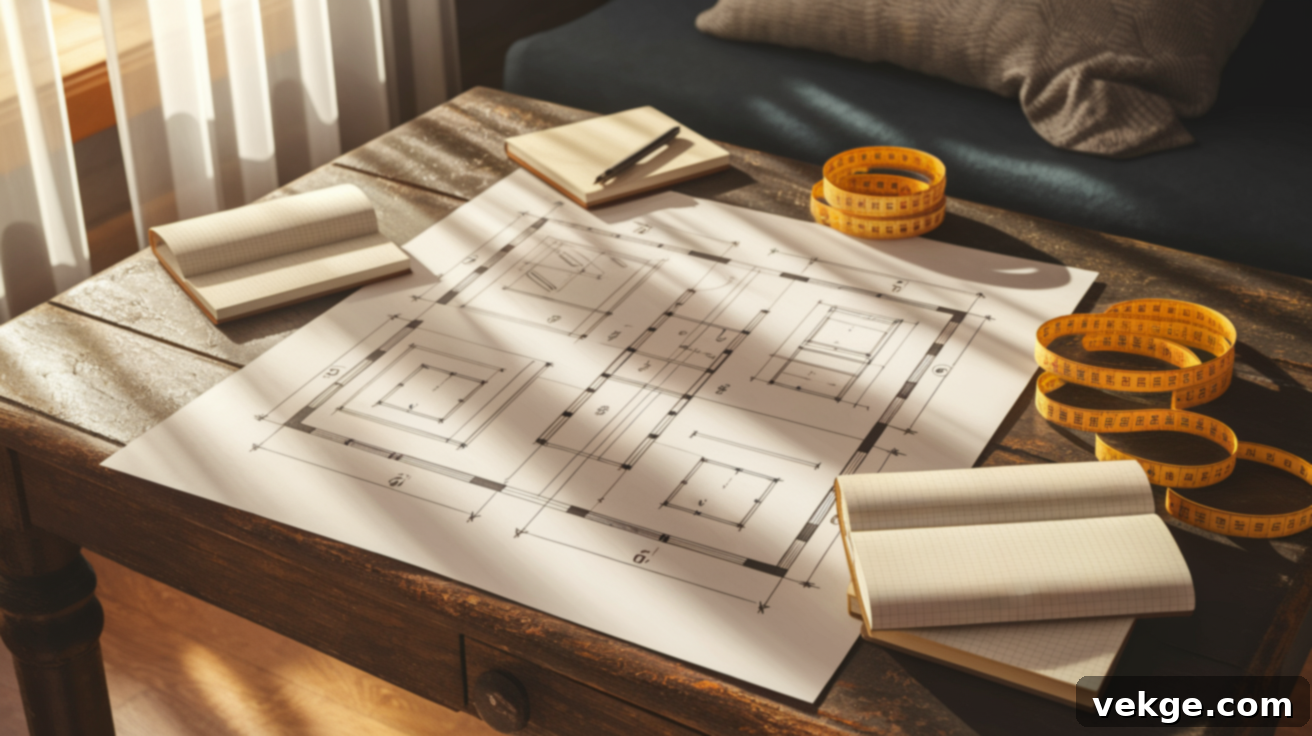
Before any furniture purchases, the absolute first step is to accurately measure your entire space. Use a reliable tape measure to record the precise length and width of all walls. Crucially, note the exact locations and swing directions of all doors, and carefully mark the placement and dimensions of all windows, considering their impact on natural light and potential furniture arrangement. Subsequently, draw a detailed floor plan, either on paper or using digital tools, clearly indicating the positions of all electrical outlets, network ports, and any permanent fixtures. This foundational step is invaluable for visualizing potential layouts and understanding spatial constraints.
Next, thoughtfully consider how each part of the room will be utilized. Designate specific zones for different activities: where will your primary focused work area be? Where are the optimal locations for collaborative meeting spots or informal breakout zones? How much space is required for essential storage solutions? Always account for adequate circulation space, allowing employees to move freely and comfortably between areas – a general guideline of at least three feet for main walkways is recommended to prevent bottlenecks. This comprehensive upfront planning is critical for avoiding common pitfalls such as purchasing oversized furniture, creating cluttered pathways, or placing items in positions that hinder movement or access. If your redesign involves clearing out outdated office equipment or furniture, working with a specialized liquidation company like Michaels Global Trading can significantly simplify the process and free up valuable space efficiently.
Select Functional and Ergonomic Furniture Wisely

Prioritize office furniture that offers multi-functionality and ergonomic benefits. Look for pieces like height-adjustable desks that cater to both sitting and standing, promoting healthier movement throughout the day, or desks with built-in storage to maximize space efficiency. Crucially, ensure chairs provide superior ergonomic support, including adjustable height, robust lumbar support, and armrests that allow users to maintain a neutral wrist position while typing. These features are vital for good posture and preventing discomfort during extended work periods.
Whenever feasible, physically test furniture before committing to a purchase; sit at various desks and evaluate chair comfort and adjustability. Opt for items that offer flexibility and adaptability – wheeled storage units, modular shelving systems, or reconfigurable workstations are excellent choices as they can be easily moved or modified as your team’s needs evolve. Additionally, pay close attention to the scale of furniture relative to your space; pieces should fit harmoniously without making the room feel either overcrowded or excessively sparse. A strategic approach involves starting with essential, key pieces and gradually adding supplementary items, rather than attempting to furnish the entire space all at once, which can lead to impulse purchases and a disjointed aesthetic.
Add Strategic Lighting to Define Spaces and Enhance Mood
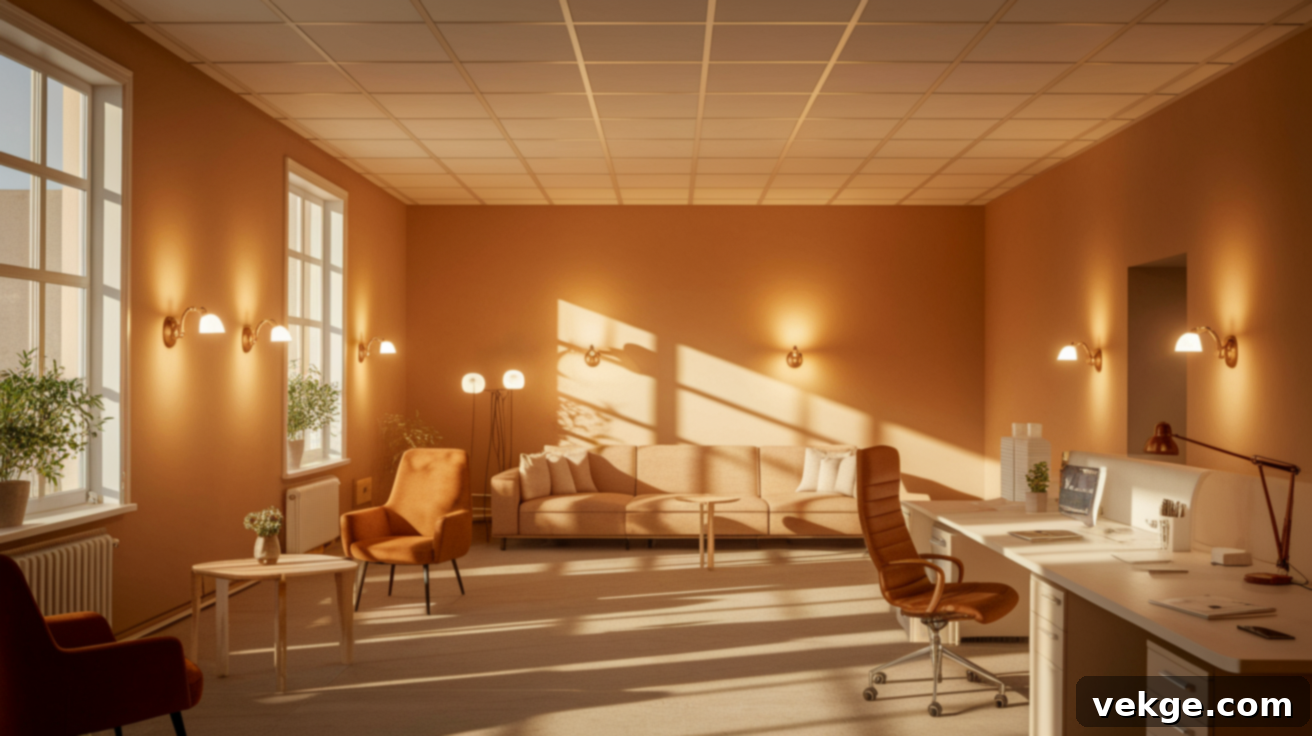
Thoughtful lighting design is paramount in a contemporary office, not only making work easier but also significantly influencing mood, energy levels, and overall atmosphere. Begin with a foundation of adequate ambient lighting provided by overhead ceiling fixtures for general illumination. Complement this with targeted task lighting, such as adjustable desk lamps, placed at individual workstations where more concentrated light is needed for detailed work or reading. This layering of light reduces eye strain and enhances focus.
Beyond functional lighting, introduce wall sconces or elegant floor lamps to accent specific areas, providing softer, more inviting illumination without the harshness often associated with solely overhead lights. Use lighting strategically to delineate different functional zones within an open-plan office – brighter, cooler-toned lighting can signify active work areas, while warmer, dimmer illumination can create a more relaxed ambiance in break rooms or casual meeting spots. Modern LED lighting options are highly energy-efficient and offer exceptional versatility, often allowing for adjustable brightness levels and color temperatures to suit varying preferences and times of day. Crucially, maximize the benefits of natural light whenever possible; arrange desks and workspaces to take full advantage of windows, positioning them to minimize glare while maximizing daylight exposure, which has proven benefits for well-being and productivity.
Personalizing Your Contemporary Office: Infusing Character and Company Culture
Adding personal touches to an office environment goes far beyond mere aesthetics; it transforms a functional space into a welcoming hub that genuinely reflects your company’s unique culture and values. Smart personalization has the power to significantly boost team morale, foster a sense of belonging, and cultivate a more pleasant, inspiring, and productive place to work. It’s about creating an atmosphere where employees feel valued, comfortable, and connected to their professional environment, ultimately enhancing both individual and collective well-being.
Thoughtful Personal Desk Accessories
Encourage staff to bring a touch of their own personality to their individual workspaces through simple, tasteful decor items that make each desk feel more welcoming and less generic. Consider incorporating small, low-maintenance plants like succulents or air plants, elegant photo frames displaying cherished memories, or well-designed desk organizers that keep the workspace tidy while adding a personal flair. The key is to maintain a balance, ensuring personal items remain neat, limited, and contribute to an organized aesthetic rather than creating visual clutter.
- For enhanced comfort and adaptability, desk lamps that staff can easily adjust to their preferred brightness and angle are highly recommended. These not only provide essential task lighting but also allow for a degree of individual control over their immediate environment.
- A small, aesthetically pleasing bulletin board or a sleek magnetic strip affixed near a desk provides a practical and personal space for notes, family photos, or motivational quotes. Even seemingly minor items, such as a favorite coffee mug or a unique pen holder, can profoundly transform a standard-issue desk into a more personalized and comfortable workstation, fostering a greater sense of ownership and well-being.
Showcasing Team Achievements and Milestones
Publicly displaying team awards, certifications, and significant milestones in common areas is a powerful way to celebrate collective successes and reinforce a culture of recognition and achievement. This practice not only boosts team pride but also serves as a continuous source of motivation and inspiration for everyone who walks through the office.
- Dedicate a prominent wall or display area for a “Wall of Fame,” featuring certificates of achievement, high-quality photographs from successful project completions, and heartfelt thank-you notes or testimonials from satisfied clients. Ensure this area is regularly updated to reflect recent wins, ongoing progress, and new team members’ accomplishments, keeping it fresh and relevant. For a dynamic approach, consider installing a digital display that rotates through team photos, key performance indicators, and recent achievements, making recognition more engaging and accessible.
- Strategically placing small trophies, plaques, or custom awards in meeting rooms or reception areas serves as a subtle yet effective reminder to both employees and visitors of your team’s collective skills, expertise, and dedication. These visible symbols of past successes can be particularly uplifting during challenging projects, fostering resilience and reminding everyone of the strength and capabilities within the team, reinforcing a positive and high-achieving mindset.
Integrating Local Artwork for Distinctive Character
Infusing your office with regional art pieces is an excellent strategy to add unique character, a strong sense of place, and a meaningful connection to the local community. It moves beyond generic office decor, providing significant visual interest and sparking engaging conversations among staff and visitors.
- Commissioning or purchasing artwork from local artists not only lends a distinctive, authentic style to your office but also provides valuable support to the local creative economy and community. Consider rotating artwork seasonally or on a quarterly basis to keep the spaces feeling vibrant and refreshed, ensuring a dynamic visual experience. Choose art that subtly reflects your company’s values, industry, or mission, creating a cohesive and inspiring narrative throughout the workspace.
- Actively involve staff in the selection process. Forming an “art committee” or conducting surveys allows employees to voice their preferences, ensuring that the chosen pieces resonate with the majority and contribute to a universally enjoyable aesthetic. This participatory approach fosters a strong sense of ownership and appreciation for the office environment.
- Local photography showcasing iconic landmarks, breathtaking nature scenes, or historical moments from your region can beautifully connect your office to its immediate geographical context, fostering a sense of community pride and local identity. Furthermore, displaying artwork created by employees themselves or their family members can imbue the workspace with deeply personal meaning and foster a strong sense of community and shared identity, making the office feel truly unique and like an extension of the people who work there.
Innovative Designs: Creative Concepts for Your Contemporary Office
A thoughtfully designed office environment has the remarkable ability to transcend its purely functional purpose, acting as a powerful catalyst for improved mood, enhanced collaboration, and heightened individual productivity. These seven innovative design ideas offer practical and inspiring avenues to transform your workspace into an environment that is both exceptionally useful and inherently pleasant. Each approach presents distinct advantages, allowing you to selectively choose or combine elements that best align with your team’s specific operational needs and your company’s unique brand identity. By strategically mixing and matching these concepts, you can curate a dynamic and fresh space that genuinely empowers everyone to perform at their absolute best and thrive within their professional roles.
1. Open-Concept Office Layout: Fostering Dynamic Collaboration
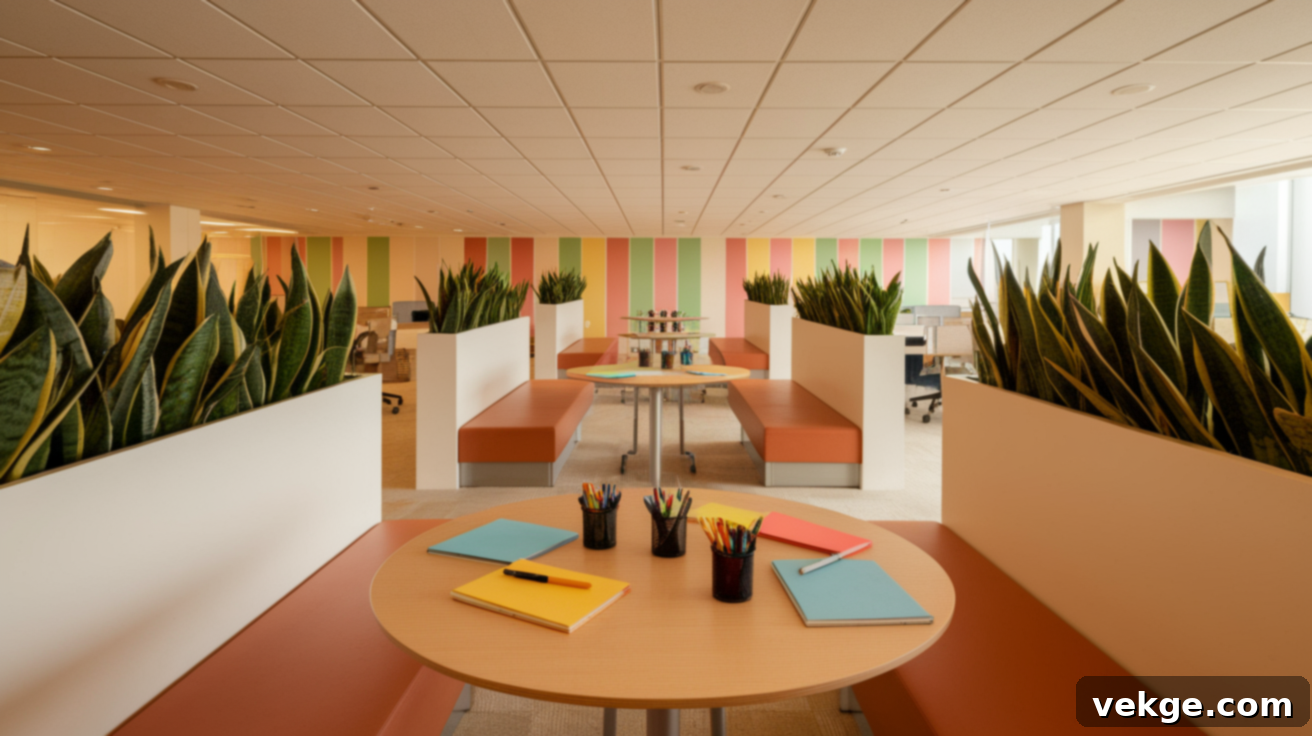
An open-concept floor plan strategically removes traditional walls and physical barriers between individual work areas, inherently promoting greater transparency and making it significantly easier for team members to engage in spontaneous conversations, share insights, and collaborate on projects. This dynamic setup is particularly effective for teams involved in fast-paced projects that demand rapid input, constant communication, and fluid idea exchange across different departments or roles. To maintain a sense of defined personal space and mitigate visual clutter without completely obstructing interaction, utilize low-height dividers, strategically placed shelving units, or artfully arranged groupings of indoor plants.
Integrate numerous small, unreserved meeting tables throughout the open space where colleagues can quickly gather for informal discussions, impromptu brainstorming sessions, or brief check-ins, eliminating the need to formally book a conference room. While fostering collaboration, managing noise levels is crucial in open offices. Implement sound-absorbing panels on walls and ceilings, use acoustic furniture, and establish clear guidelines for quiet hours or designate specific “focus zones” to ensure a balance between energetic collaboration and periods of concentrated work.
2. Home-Like Comfort in the Office: Enhancing Employee Well-being
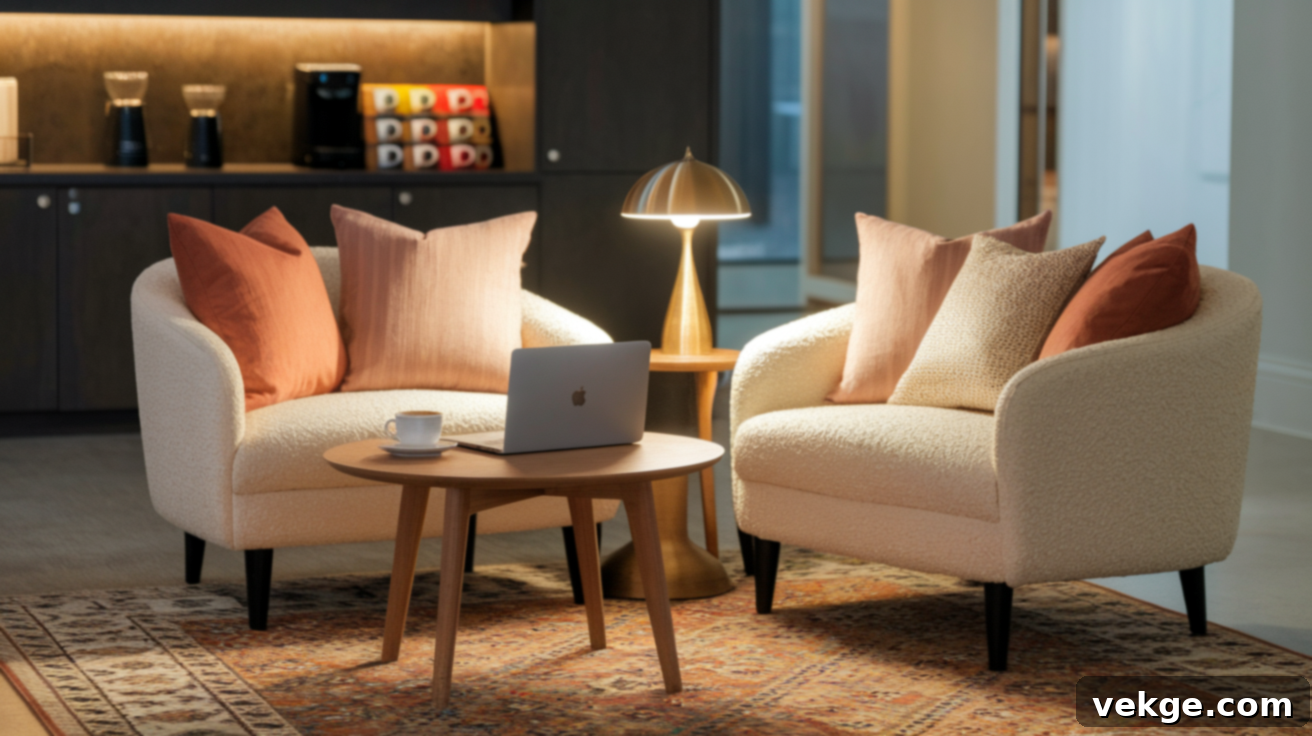
Incorporating comfortable, residential-inspired elements into the office environment can significantly enhance employee well-being, making the workspace feel more inviting, relaxed, and less institutional. Think about furnishing break areas or casual lounge zones with plush, soft couches, comfortable armchairs, and stylish coffee tables. These areas serve as informal workspaces where employees can comfortably use laptops, hold casual team meetings, or simply decompress during breaks. Area rugs are excellent for visually defining these comfortable zones, adding warmth to hard flooring and also contributing to acoustic dampening.
Elevate the break room experience by designing it like a modern kitchen, featuring high-quality coffee machines, an assortment of teas, and reusable dishes and cutlery, moving away from wasteful disposable items. Table lamps, with their softer, diffused light, can replace harsh overhead fluorescent fixtures in these areas, creating a more soothing and homely ambiance. These thoughtful touches collectively contribute to reducing workplace stress, promoting relaxation, and ensuring employees feel more comfortable and supported throughout their often-long workdays, ultimately boosting morale and loyalty.
3. Bold Statement Walls: Infusing Personality and Energy
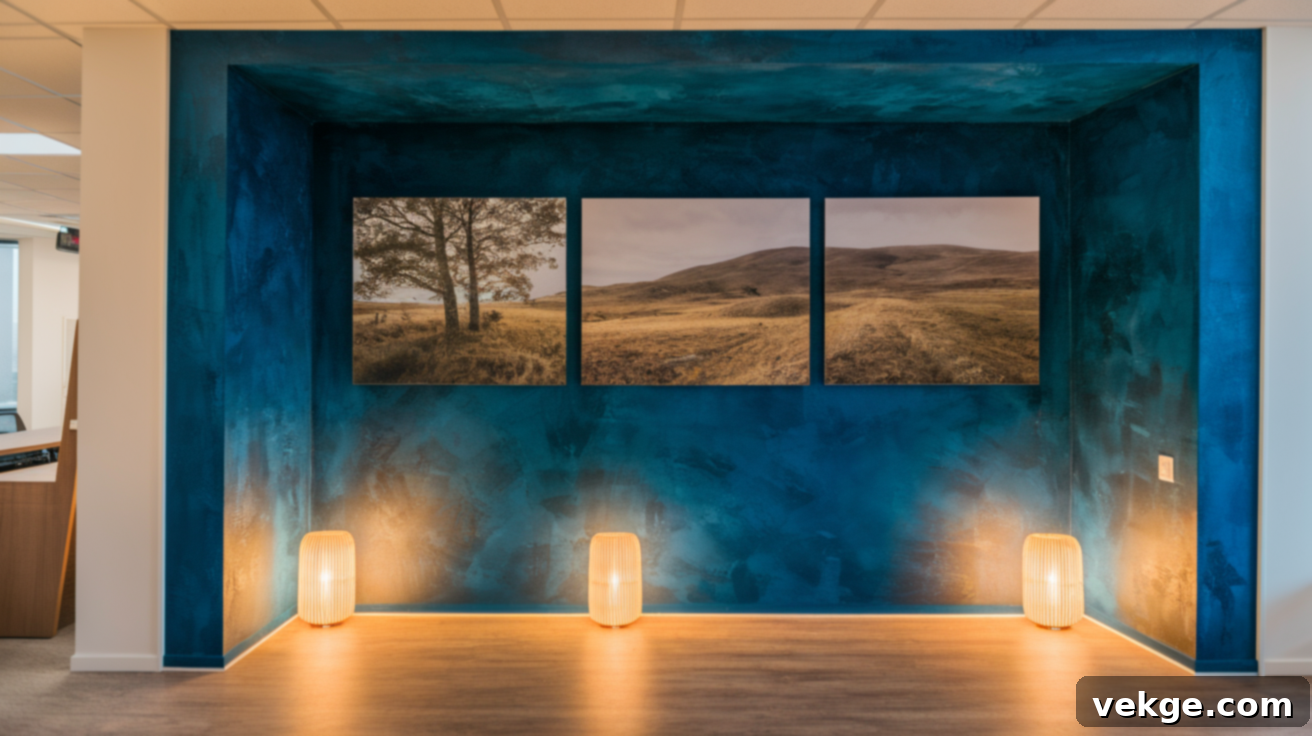
A single, strategically chosen accent wall, featuring a strong color, a distinctive wallpaper, or an interesting texture, can dramatically alter the perception and energy of a space with a relatively minimal investment. Consider rich, deep hues like sophisticated blues, lush greens, or warm terracotta tones that inject a sense of vibrancy and energy without being overly bright or distracting. Textured wall panels, particularly those with intricate 3D patterns, not only add significant visual intrigue but can also contribute to improved acoustic control by dampening sound reverberation.
For meeting rooms or collaborative zones, installing magnetic or writeable whiteboard walls adds invaluable functionality alongside a modern aesthetic, facilitating brainstorming and dynamic presentations. Large-format local artwork, custom murals, or compelling photographs can tell your company’s story, showcase its mission, or highlight local culture, serving as conversation starters and inspiration points. Even simpler design elements such as geometric painted stripes or color blocks can quickly and cost-effectively refresh an otherwise plain office, providing a dynamic visual anchor.
4. Nature-Inspired Greenery: Boosting Health and Serenity

Integrating living plants into your office environment offers a multitude of benefits, from significantly enhancing air quality and reducing stress to boosting overall mood and productivity. Begin with easy-to-care-for options that thrive in various office conditions, such as resilient snake plants, adaptable pothos, or robust ZZ plants, which can flourish even with limited natural light. Large, floor-standing plants like fiddle leaf figs or large monsteras serve not only as striking decorative elements but also function effectively as natural, soft space dividers in open-plan layouts, subtly delineating different zones.
Hanging plants, cascading from ceilings or shelves, are ideal for adding greenery to tight spaces or creating captivating visual interest at varying heights. For a truly immersive biophilic design statement, consider a living wall – a vertical garden featuring a diverse array of plant types. These dramatic installations not only purify the air on a large scale but also create a powerful visual focal point. For offices with limited resources or time for plant maintenance, high-quality artificial plants can still effectively introduce a “green” feeling and biophilic aesthetic without the ongoing care requirements, though they won’t offer the air-purifying benefits of real plants.
5. Multi-Functional Spaces: Maximizing Efficiency and Adaptability
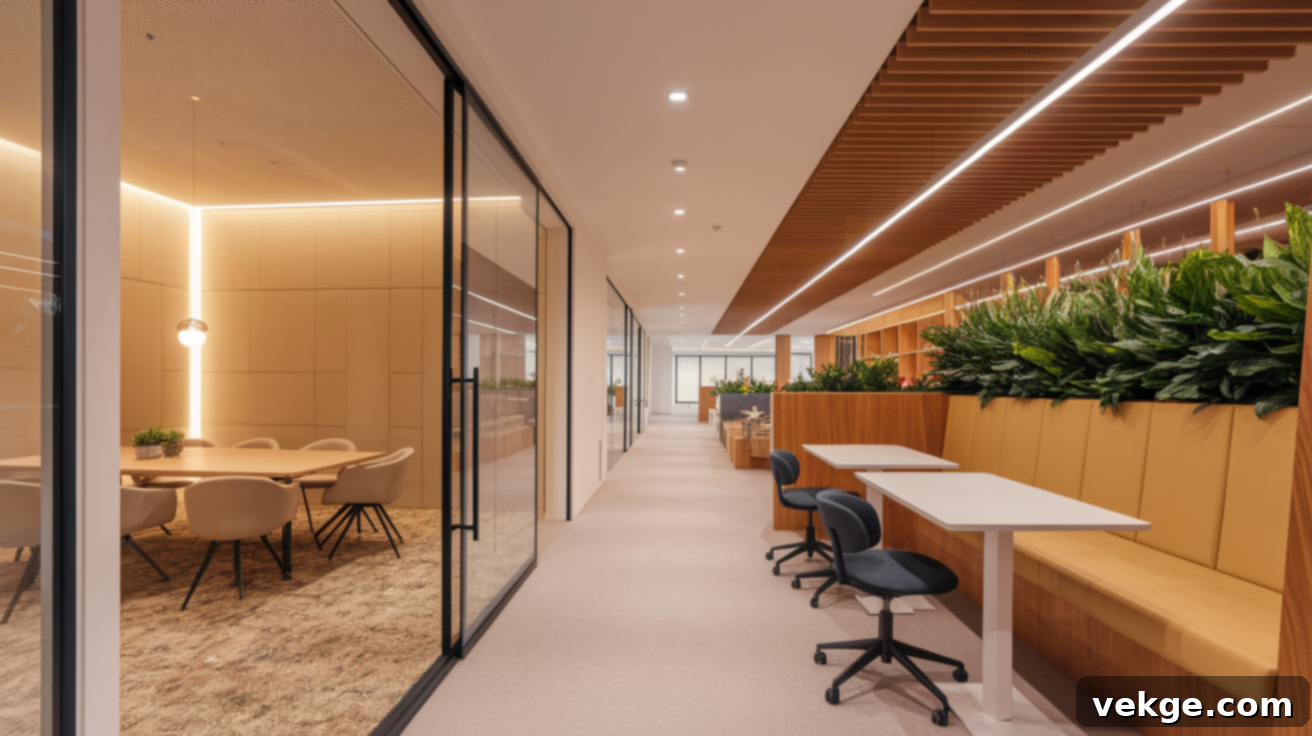
The hallmark of smart contemporary office design is the ability of each area to serve multiple purposes, maximizing efficiency and adaptability within the existing footprint. Imagine meeting rooms that can effortlessly transform into casual lunch spots or large training areas with the help of modular furniture and tables that easily fold away or reconfigure. Hallways, often overlooked, can be activated by incorporating built-in bench seating equipped with integrated power outlets, providing convenient spots for impromptu work sessions, quick calls, or informal breaks.
With the right selection of versatile furniture, reception areas can be designed to double as comfortable, casual meeting zones for clients or internal teams. Employ movable walls, rolling whiteboards, or furniture mounted on wheels to quickly and easily reconfigure spaces to suit different activities throughout the day. These flexible, multi-functional areas are particularly beneficial for smaller offices, making them feel more expansive and capable of accommodating a wider range of activities without the need for additional square footage. This approach ensures that every inch of the office contributes to productivity and adaptability.
6. Private Focus Pods: Enhancing Concentration and Privacy
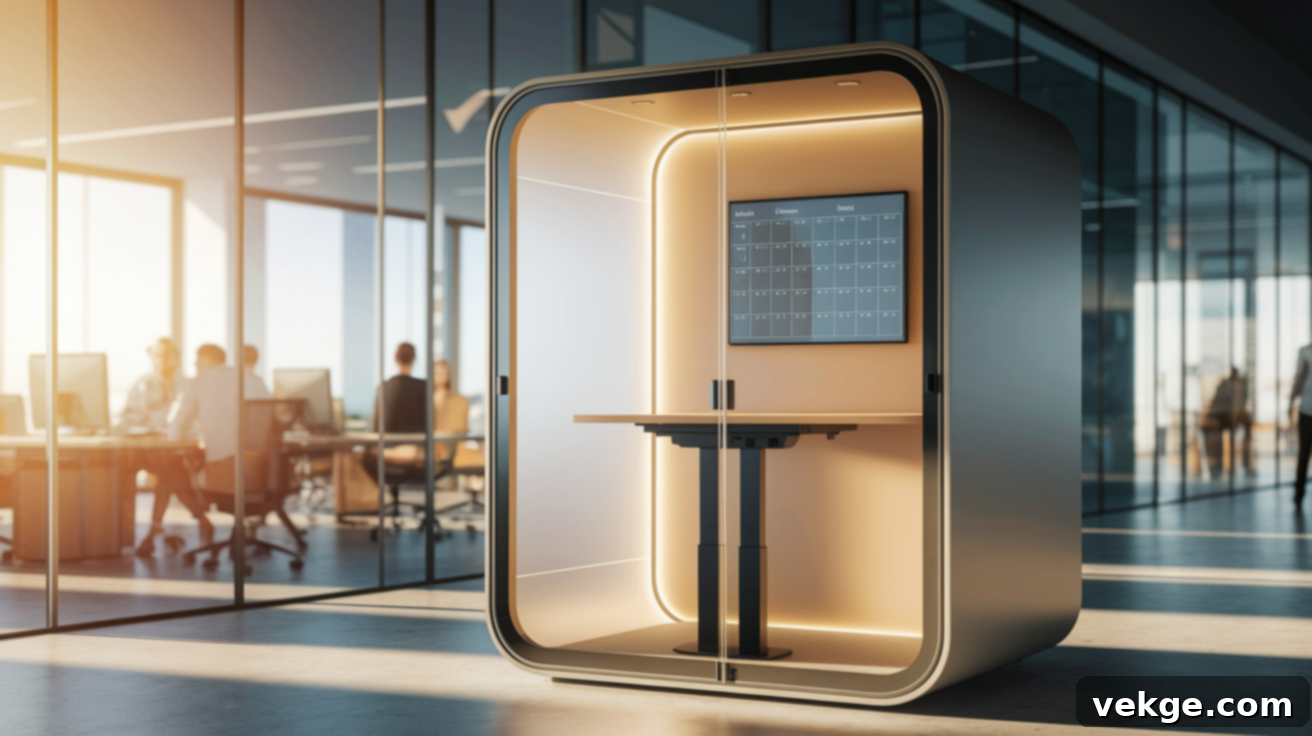
In the often-bustling environment of modern open-plan offices, dedicated small, enclosed spaces known as “focus pods” or “phone booths” are invaluable. They offer much-needed quiet sanctuaries for deep, concentrated work, private phone calls, virtual meetings, or confidential discussions. These pods can be either custom-built, permanent rooms integrated into the office architecture, or freestanding, modular structures specifically designed with superior sound control and acoustic privacy in mind. Each pod should be meticulously equipped with essential amenities, including proper, adjustable lighting, efficient ventilation systems for air circulation, and readily accessible power outlets for devices.
Many contemporary pod designs feature adjustable desks, allowing users the flexibility to work comfortably while sitting or standing, promoting ergonomic health. Implementing clear and user-friendly scheduling systems ensures that these coveted spaces are shared fairly and efficiently among team members. Even within a vibrant open-plan office, these private pods provide the crucial quiet and isolation that specific, focused tasks demand, allowing employees to escape distractions and maintain productivity. For more budget-conscious options, consider creatively converting underutilized closets into compact, private work nooks, or using tall, sound-dampening acoustic dividers to establish similar, semi-private zones within larger areas.
7. Sleek Storage Solutions: Maintaining Order and Aesthetics

Effective, sleek storage solutions are paramount in keeping contemporary offices clean, organized, and free from visual clutter, moving far beyond the era of bulky, unsightly filing cabinets. Wall-mounted shelving units are an excellent choice as they capitalize on vertical space, keeping the floor clear while providing elegant platforms for displaying books, decorative items, or team awards. Under-desk drawer units, especially those on wheels, offer personal storage that can easily be moved if employees change workstations or if the office layout is reconfigured.
Embracing digital file systems is a fundamental step in significantly reducing the need for physical paper storage, contributing to a more sustainable and minimalist office. For shared supplies or project materials, color-coded bins, stylish baskets, or transparent containers create a visually organized system that is both functional and aesthetically pleasing. Integrated or hidden storage, such as compartments within bench seating, behind sliding panels, or built into architectural features, keeps essential items conveniently accessible yet entirely out of sight, maintaining a streamlined and uncluttered appearance. Thoughtful storage planning is particularly crucial for maximizing efficiency in smaller offices and ensures that everyone can quickly locate what they need, minimizing wasted time and frustration.
Comfort Tips: Cultivating a Pleasant and Productive Contemporary Office Environment
A truly comfortable office environment is a fundamental cornerstone of employee well-being, directly contributing to heightened productivity by effectively mitigating stress, reducing physical strain, and fostering a more positive mindset. Even seemingly minor adjustments and thoughtful additions to your workspace can yield significant daily improvements in how employees feel, interact, and perform, transforming a standard office into a sanctuary of comfort and efficiency.
Ergonomic Seating for Optimal Daily Comfort
Investing in high-quality ergonomic chairs is not merely a luxury but a crucial investment in the health and sustained focus of your workforce. Superior office chairs are meticulously designed to safeguard spinal health and enable individuals to maintain concentration for longer durations without discomfort. When selecting chairs, prioritize those offering extensive adjustability, including: adjustable seat height, ensuring feet can rest flat on the floor with knees forming a 90-degree angle; robust lumbar support that conforms to the natural curve of the lower back; and height-adjustable armrests that allow wrists to remain level with the keyboard, preventing strain. These features are indispensable for promoting optimal posture and preventing musculoskeletal issues.
Beyond traditional seating, consider integrating sit-stand desks (or height-adjustable desks) into your office design. These innovative workstations empower employees to seamlessly alternate between sitting and standing positions throughout the workday. This flexibility is immensely beneficial for reducing the sedentary nature of office work, alleviating common back pain, and improving overall blood circulation, which in turn boosts energy levels and cognitive function. Offering a variety of seating options, including ergonomic stools or balance chairs, can also cater to diverse preferences and further enhance comfort and movement.
Soft Textiles for a Cozy and Inviting Touch
The strategic incorporation of various fabric elements can profoundly transform hard, utilitarian office surfaces, instantly making the entire space feel more welcoming, comfortable, and acoustically balanced. Area rugs, for instance, are not just decorative; they effectively absorb sound, reducing echo in open spaces, and add a much-appreciated layer of warmth underfoot, particularly on cold hard floors. Wall hangings, decorative fabric panels, or acoustic wall art serve a dual purpose: they introduce visual softness and artistic flair while significantly contributing to sound control by dampening reverberation that often bounces off hard walls and ceilings, creating a quieter environment.
Thoughtfully chosen window treatments, such as elegant blinds, Roman shades, or soft drapes, are essential for managing glare from sunlight, controlling heat, and adding a cohesive layer of color and texture to the room’s aesthetic. Furthermore, adding stylish throw pillows to lounge seating or even ergonomic cushions to office chairs can make long meetings or break times considerably more comfortable, inviting, and relaxing. These soft textiles also present wonderful opportunities to introduce accent colors and patterns, enhancing the office’s design without the commitment of painting or major renovations.
Personal Climate Control for Individualized Comfort
Recognizing that a single optimal temperature rarely suits everyone is a key aspect of fostering a truly comfortable and inclusive office environment. Empowering employees with a degree of personal climate control can dramatically improve their daily experience and productivity. For individuals who naturally run warm, providing small, quiet desk fans allows them to maintain a comfortable personal temperature without affecting others. Conversely, for those who easily feel cold, compact, energy-efficient space heaters can be a welcome addition, provided they meet safety standards and are used responsibly.
Easy-to-operate window blinds, shades, or smart glass systems are vital for allowing occupants to quickly manage direct sunlight and radiant heat, preventing uncomfortable glare and temperature fluctuations. Integrating high-quality air purifiers throughout the office can significantly improve air quality, particularly beneficial in older buildings or urban environments, enhancing breathing comfort and reducing allergen exposure. The most forward-thinking contemporary offices strive to offer micro-climates or localized settings where possible, enabling subtle variations in temperature or airflow in different zones. This personalized approach to comfort ensures that every team member can work at their absolute best, free from environmental distractions or discomfort, ultimately leading to higher satisfaction and engagement.
Maintenance Tips for a Long-Lasting and Immaculate Contemporary Office
Diligent and regular maintenance is not merely about preserving the aesthetic appeal of your contemporary office; it is a critical practice that ensures the longevity, functionality, and cost-effectiveness of your investment. Proactive care prevents premature wear and tear, effectively minimizing the need for expensive repairs or complete replacements down the line. By adhering to a consistent, well-structured maintenance routine, you can keep your office looking pristine, operating efficiently, and providing a healthy, inspiring environment for years to come.
- Implement Regular Surface Cleaning Protocols: Establish a robust routine for cleaning all office surfaces. For wood finishes, regularly dust with a soft, lint-free cloth and, periodically, apply a suitable wood cleaner or polish to maintain its natural luster and protect against drying and minor scratches. Glass surfaces, such as desk tops, dividers, and windows, should be wiped down weekly, or more frequently in high-traffic areas, using a streak-free glass cleaner to ensure transparency and sparkle. Metal accents, including door handles, desk frames, and decorative elements, benefit from regular cleaning with a gentle metal polish to prevent tarnishing, corrosion, and to restore their inherent shine. Crucially, address any spills immediately with the appropriate cleaning agent to prevent stains from setting in, which can be much harder to remove later and potentially cause permanent damage.
- Conduct Routine Furniture Inspections and Preventative Repairs: Regularly inspect all office furniture for signs of wear and tear, and address issues promptly. Pay particular attention to ergonomic chairs: check wheels for smooth movement and replace any that are worn, cracked, or jammed to prevent floor damage and ensure easy mobility. On desks, shelves, and cabinets, periodically tighten any loose screws or bolts, typically every few months, to maintain structural integrity and prevent wobbling or instability. Examine fabric upholstery on chairs and soft seating for fraying, tears, or excessive pilling, and arrange for early repair or professional cleaning to prevent further damage and maintain a fresh appearance. Test all moving parts, such as desk drawers, keyboard trays, and adjustable mechanisms, to identify and rectify any stiffness, grinding, or alignment issues before they escalate into larger, more costly problems. This proactive approach significantly extends the lifespan of your furniture and ensures optimal functionality.
- Optimize Plant and Greenery Care: For offices incorporating live plants, establish a consistent and appropriate watering schedule tailored to the specific needs of each plant species, considering factors like light exposure, pot size, and humidity levels. Regularly remove any dead, yellowing, or diseased leaves and stems promptly to encourage new growth, prevent pests, and maintain a healthy, vibrant appearance. To ensure even growth and prevent plants from leaning excessively towards light sources, rotate them quarterly. Crucially, check soil moisture levels weekly by feeling the soil a few inches deep; adjust your watering frequency as seasons change, or as the office environment’s humidity fluctuates, to avoid both over and under-watering. For living walls or complex plant installations, consider contracting professional maintenance services to ensure their sustained health, ecological benefits, and visual impact.
Common Mistakes to Avoid in Contemporary Office Design
Even the most meticulously planned office renovations can encounter challenges or fall short of expectations if certain prevalent issues are overlooked or underestimated during the design and implementation phases. Being acutely aware of these common design pitfalls will significantly empower you to create a superior, more functional, and universally appealing workspace for every individual who uses it, ensuring your investment truly pays off and contributes positively to your organizational goals.
- Overcrowding the Space: One of the most frequent and detrimental errors is attempting to fit too much furniture or too many workstations into a given area. An overcrowded office immediately creates a sense of claustrophobia, makes movement difficult, inefficient, and unsafe, and contributes significantly to visual stress and mental fatigue among employees. It can also severely restrict the flow of natural light and make the entire office feel disorganized and oppressive. To maintain an open, airy, and functional flow, ensure there is ample space for circulation; a general guideline suggests leaving at least three feet of clear walkway space between desks and other major furniture items. Prioritize fewer, multi-functional pieces over numerous single-purpose items, and always refer back to your initial layout plan to ensure spatial balance and comfort.
- Ignoring Acoustic Comfort: In the pursuit of sleek, open-plan aesthetics, acoustic comfort is often inadvertently neglected, leading to excessively noisy environments that severely impede focus, significantly increase stress levels, and reduce overall productivity. Uncontrolled sound—emanating from conversations, phone calls, keyboard clicks, and even HVAC systems—creates a constant barrage of distractions. To effectively mitigate this, integrate sound-absorbing materials strategically throughout the office: install high-performance acoustic panels on walls and ceilings, utilize soft furnishings like plush carpets, upholstered furniture, and heavy drapes, and incorporate natural elements such as large, leafy plants which can help diffuse sound. Consider implementing white noise machines or designating specific, sound-isolated “quiet zones” or focus pods to provide essential respite from the general office din.
- Skipping Employee Input: A critical and often costly mistake is designing or redesigning an office without actively consulting the very people who will be using it daily. Employees are the ultimate experts on their workflow, their specific needs for focused work, collaborative interaction, and relaxation. Failing to gather their invaluable feedback can lead to a beautifully designed but ultimately dysfunctional space that doesn’t genuinely support their actual work processes and preferences. Before making significant changes, conduct thorough surveys, hold inclusive focus groups, or establish a representative design committee that includes members from various departments. Their insights are indispensable for identifying pain points, understanding requirements for diverse work styles, and ensuring that the new design genuinely enhances their ability to perform their jobs effectively, comfortably, and happily. This participatory approach fosters a strong sense of ownership, boosts morale, and makes the transition to the new space much smoother and more successful.
Conclusion: Crafting a Future-Ready, Inspiring Contemporary Office
Embarking on the journey of creating a truly remarkable contemporary office environment doesn’t have to be an overwhelming or overly complex undertaking. The core principle lies in a thoughtful, strategic approach, beginning with foundational elements and progressively adding layers of functionality, comfort, and personalization. Start by making informed choices regarding quality materials: opt for natural wood finishes to infuse warmth and organic texture, incorporate sleek metal accents to provide structural integrity and a touch of modern sophistication, and leverage expansive glass surfaces to maximize natural light and foster an undeniable sense of openness and transparency throughout your workspace.
Careful and meticulous planning of your office layout is paramount, as it dictates workflow, enhances collaboration, and supports individual focus. Select versatile furniture pieces that serve multiple purposes and adapt seamlessly to evolving needs, moving away from single-use items. Harness the power of strategic lighting to not only illuminate but also to subtly define distinct zones within your workspace, enhancing mood, reducing eye strain, and optimizing task efficiency. Beyond the essentials, elevate your design with creative elements that invigorate the space: introduce vibrant greenery to boost well-being and air quality, integrate comfortable, home-like seating to encourage relaxation and informal collaboration, and implement intelligently designed storage solutions to maintain a pristine, clutter-free, and highly organized environment.
Finally, to truly make the space special and reflect your unique brand identity, infuse it with authentic personal touches. Display team achievements to celebrate collective success and foster pride, and incorporate locally sourced artwork to add distinctive character, cultural richness, and a meaningful connection to your community. By diligently following these integrated steps and avoiding common pitfalls, you will craft an office that is far more than just a place of work; it will be a dynamic, inspiring ecosystem that profoundly supports both heightened productivity and holistic employee well-being. The most successful workspaces are not static but fluid – constantly evolving and adapting alongside the people who inhabit them, ensuring that your contemporary office remains a continually inspiring and empowering experience for everyone who walks through its doors, fostering innovation, collaboration, and a thriving work culture for years to come.
